Santorini Beyond the Crowds: What to See and...
Discover hidden beaches, authentic tavernas, ancient...
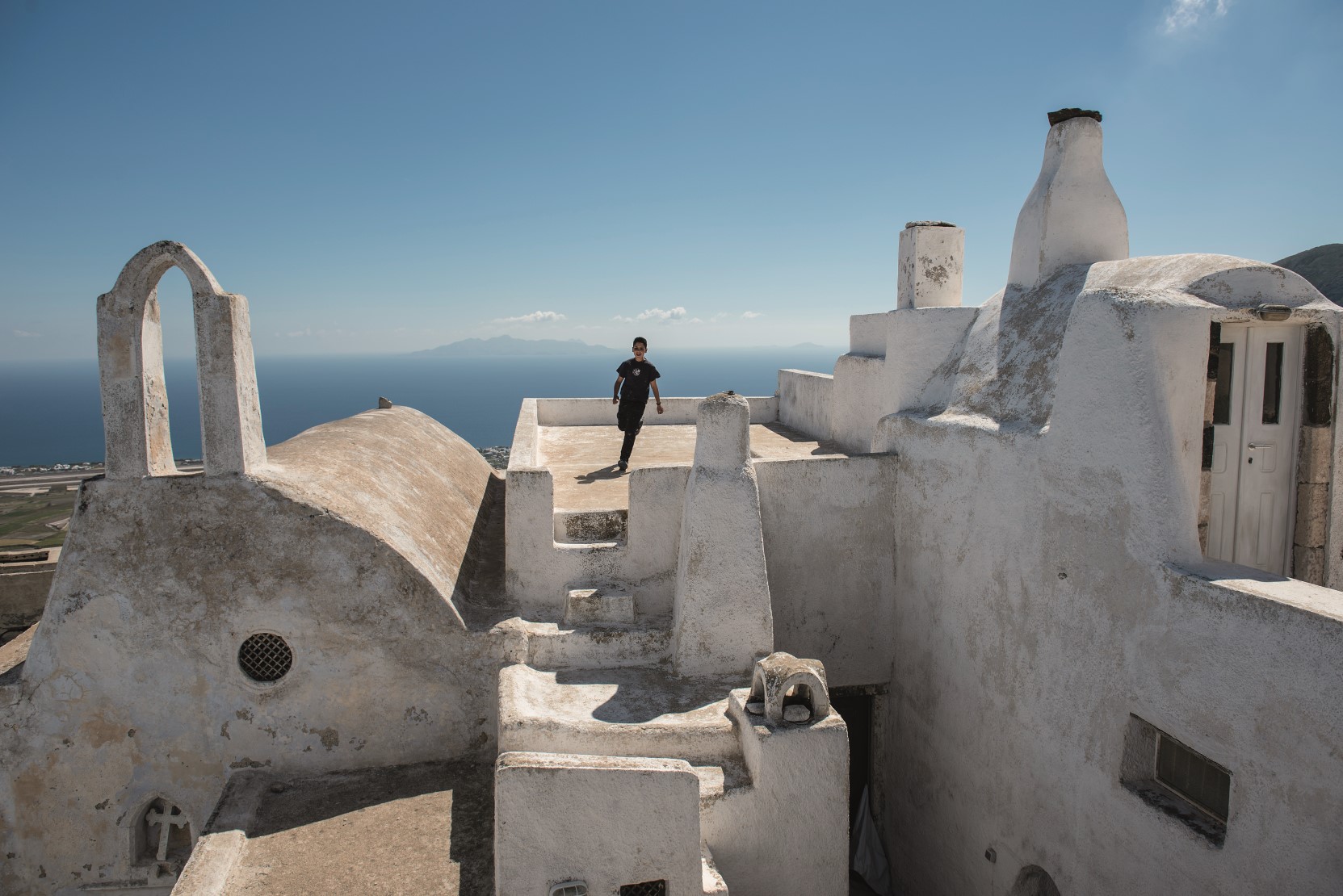
The beautiful village of Pyrgos.
© Vangelis Zavos
No matter how many times you stand there gazing over the caldera, you’ll never feel that you have had enough of it.
It is an inescapable fact, even for those who spend every summer and winter here for their entire lives.
Each time you look out across this spectacular absence of solid earth, a void embraced by the island’s curving cliffs, you’re amazed all over again.
Still, Santorini isn’t just the caldera, the swimming pools and the cruise ships, and it certainly won’t be just that this year.
This summer offers a unique opportunity for you to see the island with a very different eye and at a slower pace; the beaches will be quieter, the lines at archaeological sites will be shorter, and you’ll be able to wander in relative solitude around its villages.
The local Assyrtiko wine will still be delicious, but the bars won’t be as crowded, and nor will the hiking trails.
This year, a different Santorini awaits you, and it’s all yours.
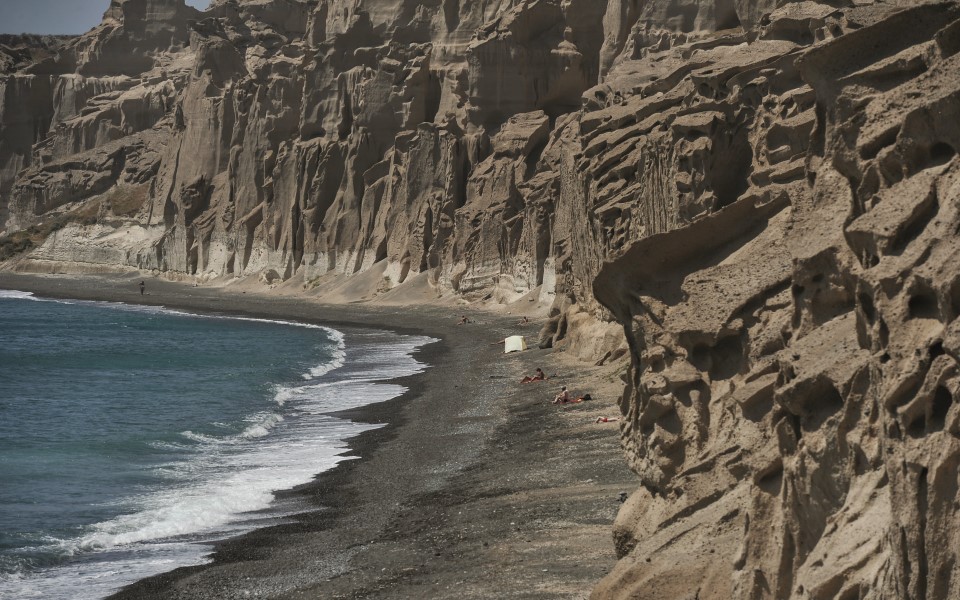
The imposing scenery at Vlychada beach.
© Vangelis Zavos
If you prefer unspoiled natural beauty to modern amenities, there are plenty of beaches free of sun loungers.
Katharos (in the northwest), with sand and small pebbles, is a great choice that also offers a wonderful sunset view.
A favorite with the more adventurous is Koloumbo (in the north), where swimsuits are optional. Park on the main road and walk 10 minutes down the grassy path. Around seven miles offshore there’s a submerged volcano of the same name.
Fifty steps lead down to Pori (in the northeast), a sandy beach that locals love.
Little-known Almyra (in the south) can be accessed via a narrow dirt road.
Santorini isn’t an obvious destination for hikers, but its walking paths hold many unexpected delights.
The island’s most scenic trail is a 9.8km stone-paved route that follows the rim of the caldera and connects Fira and Oia.
Start around 16.30 from Fira to make sure you catch the sunset at Oia. If, however, you’re after a road less traveled, try looking inland: follow the old path that connects Pyrgos to Exo Gonia and Episkopi Gonia, where you‘ll discover ghostly neighborhoods of abandoned rock-hewn structures.
Another option is the trail between Vothonas and Messaria, whose highlights include the Chapel of Panaghia Sergena, carved into a cliff-face; and one of the island’s most impressive ravines.
For the past 20 years, Nikos Boutsinis has walked the length and breadth of Santorini, revealing the villages and their secrets to the groups he guides (santoriniwalkingtours. com, Tel. (+30) 697.160.3600).
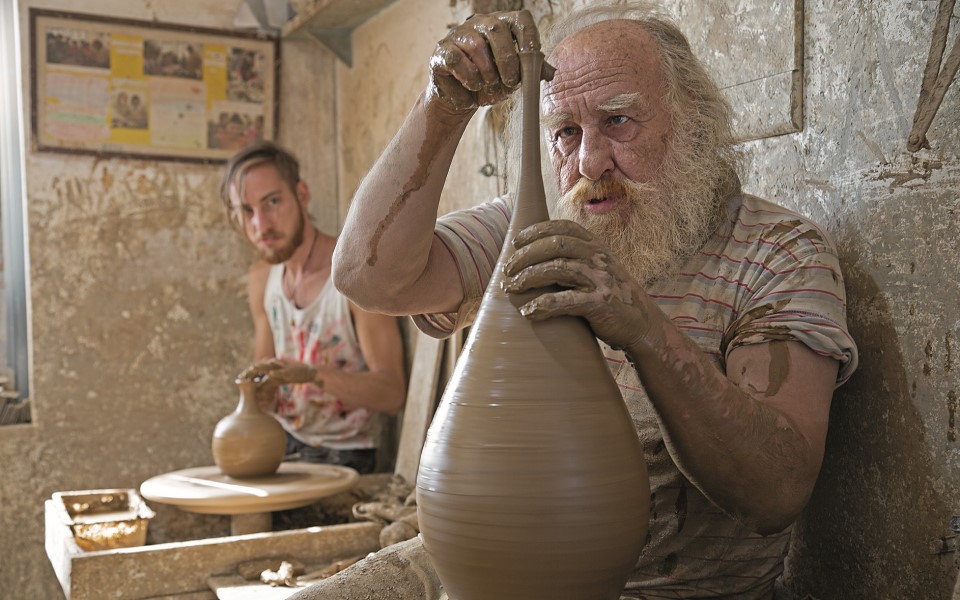
Artist Andreas Makaris and his son Orfeas at the ceramics workshop "Earth and Water" in Megalochori.
© Nikos Pilos
Pyrgos, once the island’s capital, is its highest village.
A short ascent will be required, but you’ll be rewarded with treasures such as the Theotokaki, a tiny 14th-century chapel, and a panoramic view of the nearby islands.
If you have a penchant for antiques, a veritable mother lode awaits you here at Crossroad Antiques.
Emporio is an enchanting maze of small houses, arches and passageways so narrow at some points that only one person can squeeze through at a time.
Before leaving, take time for a Greek coffee at one of its two traditional cafés, among the most charming on the island.
It’s well worth spending a day at Megalohori, in the region of the island’s southern vineyards.
Two of the most well-known wineries, the traditional winery of Gavalas and the impressive rock-hewn winery of Venetsanos, are located here.
The central stone paved road was once a riverbed and even today this central cobblestone road is still referred to as the “River.”
Dusk here is beautiful, and there are a number of churches with intricate belfries, including the Church of Zoodohos Pigi and the Church of Panaghia in the main square.
From the veranda of the restaurant Feggera, you can hear the horses crossing the “River,” whereas a few meters further, at Symposion by La Ponta (www.symposionsantorini.com), what you’ll hear is music, and plenty of it as the sounds of the traditional bagpipes of the Cycladic islands and of ancient phorminxes fill the vaulted interior.
The hosts, Argy Kakissis and Yiannis Pantazis, will happily take you on a guided tour. Yiannis makes musical instruments, and gives music lessons and concerts in this melodious multi-space.
Don’t leave the village without buying a leather souvenir from “Transit” or a ceramic object from the workshop of Andreas Makaris.
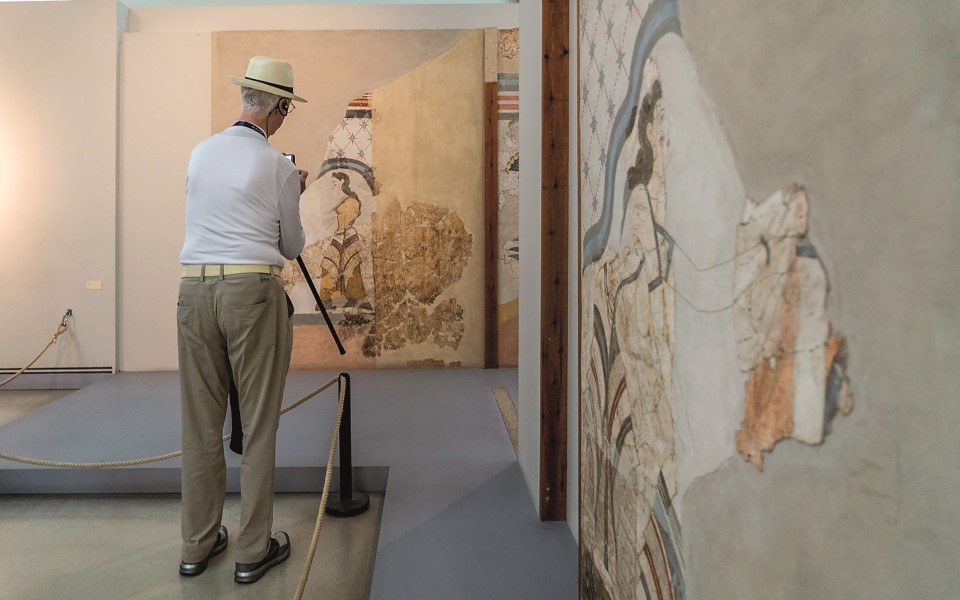
The Museum of Prehistoric Thira.
© Perikles Merakos
Stunning views and historical significance combine to make a visit to Ancient Thera, high up on the hill of Mesa Vouno, an unmissable experience.
One moment you’ll be admiring the ruins of a city inhabited from the 9th century BC to AD 726, and the next you’ll be looking out across both the eastern and western sides of the island.
You’ll need closed footwear, a hat, sunscreen and water. Make sure to have cash on you – the ticket booth does not accept credit cards (admission €4, open TueSun, 08:30-16:00).
Santorini’s museums hold fascinating collections that illuminate the island’s past.
Start with the Santorini Museum of Prehistoric Thira and its impressive exhibit items, many of which were found at Akrotiri.
Among the objects on view is a bathtub from the 17th century BC, a golden chamois figurine and impressive frescoes, including those of the Fisherman and the Blue Monkeys (Fira, Tel. (+30) 228.602.3217, open everyday except Tuesdays between 08.30 -16.00).
Drop by the Maritime Museum of Thera in Oia, a renovated two-story sea captain’s house with a cobblestoned courtyard, to see rare 17th-century figureheads, models of ships that belonged to old seafaring families, nautical instruments and marine watercolors (405 25th March, Oia, Tel. (+30) 22860.711.56, open daily except Tue, 10:00-14:00 & 17:00- 19:00).
The old factory that once processed one of Santorini’s most famous agricultural products, the local cherry tomato, has been transformed into the Tomato Industrial Museum.
Visitors can see the old production line and try the tomato paste (exclusive to the museum) that’s made using traditional methods.
The museum is housed in the main building of the plant, which operated from 1945 to 1981.
The whole complex, which also houses cultural activities, is known as the Santorini Arts Factory (Vlychada, open Tue-Sun, 10:00-18:00, Tel. (+30) 22860.851.41).
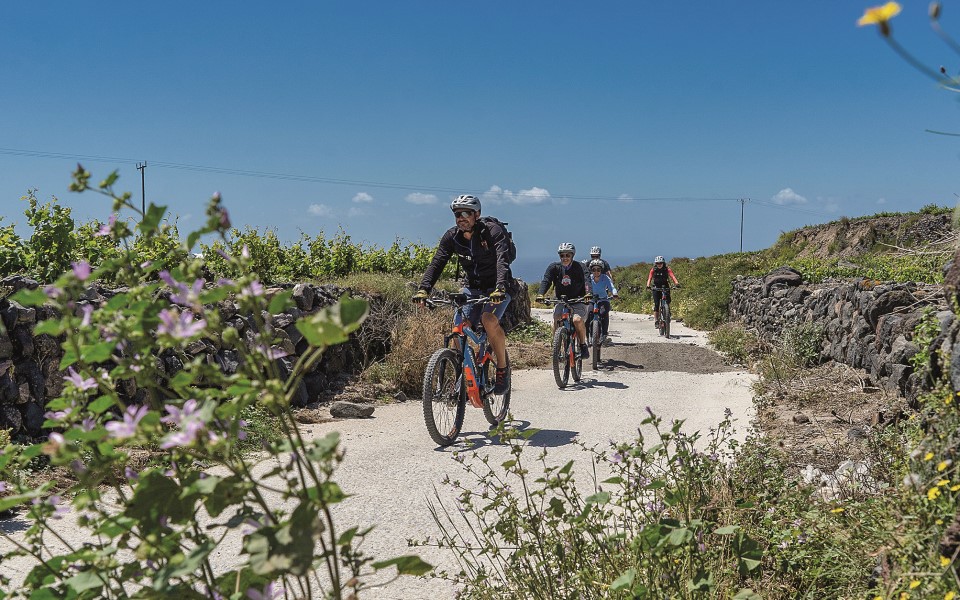
Cycling tours on the island offer many enjoyable surprises.
© Perikles Merakos.
Have you thought about biking the island but paled when you saw the hills?
One delightful cycling tour in southern Santorini, covering a distance of 26km, starts at Perivolos Beach, continues along country lanes to Emporio, and then follows the wine roads as far as Megalochori, before ending up back at Perivolos.
You don’t need to worry about getting tired, because you‘ll be riding electric-powered mountain bikes from Santorini Mountain Bike Adventures (santoriniadventures.gr, Tel. (+30) 698.028.9453).
Watching a movie outside on a warm summer night is a great Greek summer experience, and the perfect place for this is at Kamari’s open-air cinema, listed among the Guardian’s top ten open-air cinemas worldwide.
Catch the latest blockbuster in a lush garden, with a well-mixed cocktail or cold beer in hand (Kamari, Tel. (+30) 22860.334.52). Movies start at 21:30, but you’ll want to get there early to grab one of the sought-after chaises longues.
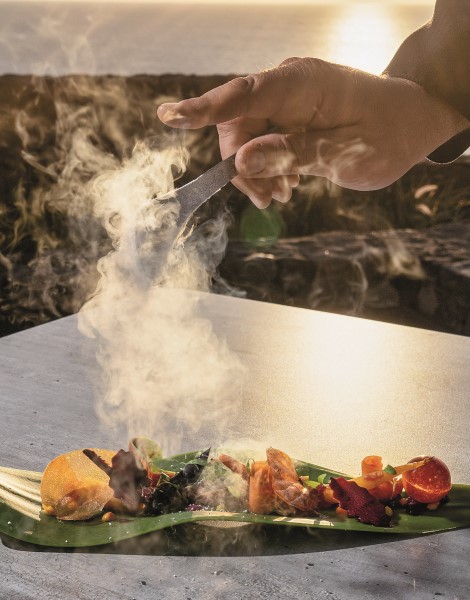
Modern high-caliber gastronomy at the restaurant Elements in the resort Canaves Oia Epitome
© Perikles Merakos

Wine selections from all local wineries are available in the charming courtyard of Oia Vineyart.
© Perikles Merakos
Some of the most prominent Greek wines are produced in the vineyards on Santorini, where there have been grapes growing for more than 3,000 years.
If you happen to be on the island around mid-August during the grape harvest, you’ll notice that the air in the countryside is pungent with the fragrance of grape juice.
At the twenty or so wineries on the island (almost all of them open to visitors), you’ll be able to discover all the different incarnations of Assyrtiko.
Aged in oak barrels stored in cool, old traditional wineries hewn out of the volcanic rock, called kanaves, or fresh from wine tanks in state-of-theart modern wineries, you’ll find a label that is sure to become your very own favorite.
After a couple of tastings, you’ll be able to discern the unique features and the soft touch of the local terroir in the other indigenous varieties that are cultivated here, including other whites such as Athiri and Aidani, and reds like Mavrotragano and Mandilaria.
Across the island, and more especially at Oia, Imerovigli and Fira, there are prestigious upscale restaurants: Santorini is Greece’s undisputed gastronomical catwalk.
Dining at one of these, with its impeccable service, exquisite wine and atmosphere to match will undoubtedly be a highlight to remember.
There is perhaps a qualitative gap on the island as regards medium-range restaurants, but if you venture to villages and smaller settlements off the beaten path, you’ll find many wonderful small tavernas, as well as a few low-key restaurants that are well worth trying out.
The taverna Krinaki at Finikia is ideal for grilled meats and vegetable stews, the Postalia tou Aegaiou at Messaria is perfect for ouzo and meze, while Roza at Vourvoulos is a modern restaurant with very tasty simple fare.
Metaxi Mas, at Exo Gonia, is always full of customers who appreciate the high quality of its food. Among the best seafod options on the island is Psaraki, overlooking the small harbor of Vlyhada, but if you’re looking for seafood at the water’s edge in a relaxed, authentic environment, then try Armeni at the charming small harbor of the same name.
At the wine bar Oia Vineyart, they cook a variety of tasty dishes using local produce from Santorini and from across Greece, and they serve all the wine labels produced by local wineries.
Discover hidden beaches, authentic tavernas, ancient...
From Samos to Crete, we've selected...
From Santorini sunsets to ancient ruins,...